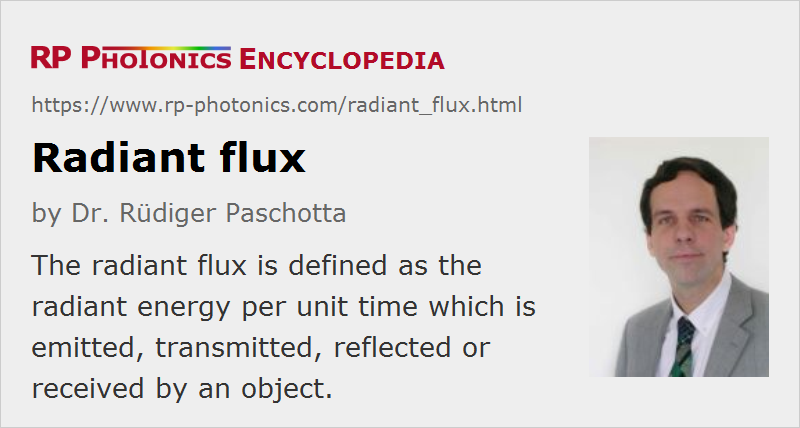Radiant Flux
Definition: radiant energy per unit time which is emitted, transmitted, reflected or received by an object
Alternative terms: radiant power, optical power
German: Strahlungsleistung
Categories: general optics, light detection and characterization, optical metrology
Formula symbol: Φe
Units: W
How to cite the article; suggest additional literature
Author: Dr. Rüdiger Paschotta
The radiant flux is a term of radiometry. It is defined as the radiant energy per unit time which is emitted, transmitted, reflected or received by an object. In case of light, it is also simply called the optical power. However, the term radiant flux can be used for any kinds of electromagnetic radiation, including e.g. X-rays, ultraviolet light, infrared light and terahertz radiation.
A related quantity is the spectral flux, defined as the radiant flux per unit frequency or wavelength interval. The units are then W/Hz or W/nm, for example.
Questions and Comments from Users
Here you can submit questions and comments. As far as they get accepted by the author, they will appear above this paragraph together with the author’s answer. The author will decide on acceptance based on certain criteria. Essentially, the issue must be of sufficiently broad interest.
Please do not enter personal data here; we would otherwise delete it soon. (See also our privacy declaration.) If you wish to receive personal feedback or consultancy from the author, please contact him e.g. via e-mail.
By submitting the information, you give your consent to the potential publication of your inputs on our website according to our rules. (If you later retract your consent, we will delete those inputs.) As your inputs are first reviewed by the author, they may be published with some delay.
See also: radiant energy, optical power, radiant intensity, optical intensity, irradiance, radiometry
and other articles in the categories general optics, light detection and characterization, optical metrology
 |







2020-05-23
I would like to find the power per unit area reached.
Answer from the author:
Look for irradiance or optical intensity. (Radiant intensity is something different.)